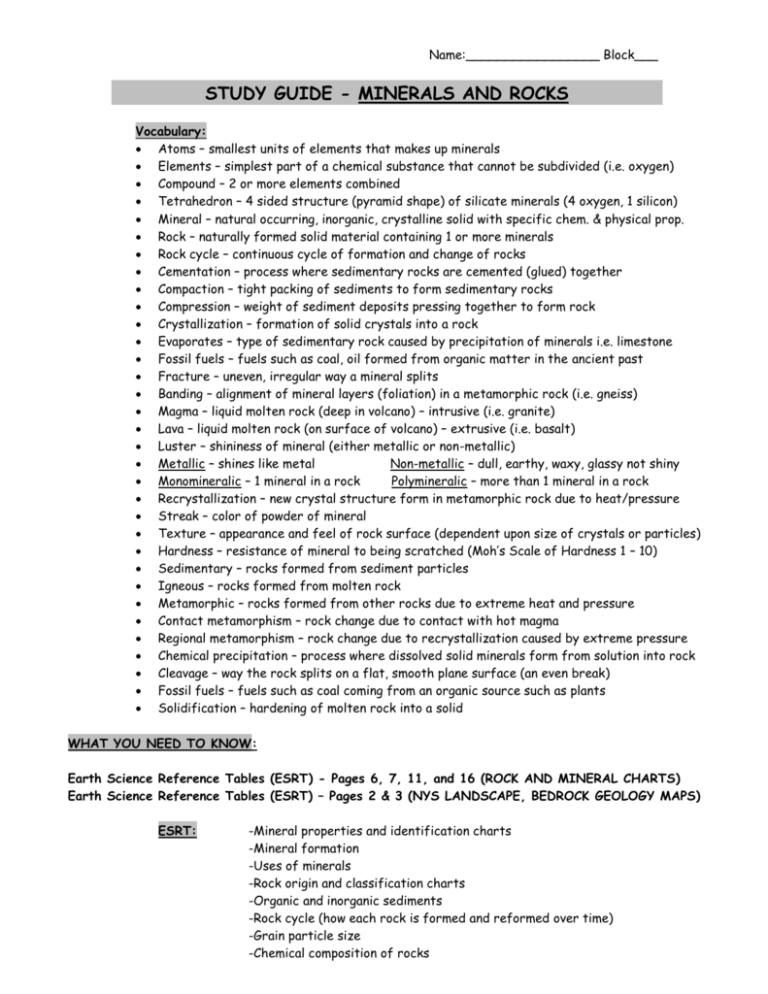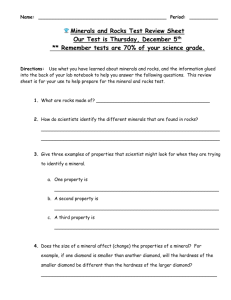Study Guide - Rocks and Minerals
advertisement

Name:_________________ Block___ STUDY GUIDE - MINERALS AND ROCKS Vocabulary: Atoms – smallest units of elements that makes up minerals Elements – simplest part of a chemical substance that cannot be subdivided (i.e. oxygen) Compound – 2 or more elements combined Tetrahedron – 4 sided structure (pyramid shape) of silicate minerals (4 oxygen, 1 silicon) Mineral – natural occurring, inorganic, crystalline solid with specific chem. & physical prop. Rock – naturally formed solid material containing 1 or more minerals Rock cycle – continuous cycle of formation and change of rocks Cementation – process where sedimentary rocks are cemented (glued) together Compaction – tight packing of sediments to form sedimentary rocks Compression – weight of sediment deposits pressing together to form rock Crystallization – formation of solid crystals into a rock Evaporates – type of sedimentary rock caused by precipitation of minerals i.e. limestone Fossil fuels – fuels such as coal, oil formed from organic matter in the ancient past Fracture – uneven, irregular way a mineral splits Banding – alignment of mineral layers (foliation) in a metamorphic rock (i.e. gneiss) Magma – liquid molten rock (deep in volcano) – intrusive (i.e. granite) Lava – liquid molten rock (on surface of volcano) – extrusive (i.e. basalt) Luster – shininess of mineral (either metallic or non-metallic) Metallic – shines like metal Non-metallic – dull, earthy, waxy, glassy not shiny Monomineralic – 1 mineral in a rock Polymineralic – more than 1 mineral in a rock Recrystallization – new crystal structure form in metamorphic rock due to heat/pressure Streak – color of powder of mineral Texture – appearance and feel of rock surface (dependent upon size of crystals or particles) Hardness – resistance of mineral to being scratched (Moh’s Scale of Hardness 1 – 10) Sedimentary – rocks formed from sediment particles Igneous – rocks formed from molten rock Metamorphic – rocks formed from other rocks due to extreme heat and pressure Contact metamorphism – rock change due to contact with hot magma Regional metamorphism – rock change due to recrystallization caused by extreme pressure Chemical precipitation – process where dissolved solid minerals form from solution into rock Cleavage – way the rock splits on a flat, smooth plane surface (an even break) Fossil fuels – fuels such as coal coming from an organic source such as plants Solidification – hardening of molten rock into a solid WHAT YOU NEED TO KNOW: Earth Science Reference Tables (ESRT) - Pages 6, 7, 11, and 16 (ROCK AND MINERAL CHARTS) Earth Science Reference Tables (ESRT) – Pages 2 & 3 (NYS LANDSCAPE, BEDROCK GEOLOGY MAPS) ESRT: -Mineral properties and identification charts -Mineral formation -Uses of minerals -Rock origin and classification charts -Organic and inorganic sediments -Rock cycle (how each rock is formed and reformed over time) -Grain particle size -Chemical composition of rocks WHAT YOU NEED TO REMEMBER: Minerals have different chemical and physical properties because of their atomic structure Internal arrangement of atoms determines the physical and chemical properties of the minerals All rocks are composed of minerals (minerals are NOT composed of rocks) Crystalline structure of silicate minerals is tetrahedron (4 oxygen atoms and 1 silicon atom) MINERALS ARE IDENTIFIED BY THEIR SPECIFIC PROPERTIES: luster, color, hardness, streak, cleavage and fracture. ROCKS ARE CLASSIFIED BY THEIR PLACE OF FORMATION (ORIGIN): SEDIMENTARY – formed under water from sediments on the Earth’s surface by compaction, compression, cementation, and burial of sediments; also evaporation and precipitation (i.e. limestone) *fossils are found ONLY in sedimentary rocks (unless the sedimentary rock has metamorphosed) Sequence of events for sedimentary rock formation: rock erodes…….….sediments deposited and buried…..….sediments compacted and cemented together IGNEOUS – formed from molten rock from a volcano (intergrown crystals) Intrusive – magma deep in volcano – slow cooling, large crystal, coarse texture (i.e. granite) Extrusive – lava on surface of volcano – fast cooling, small crystal, fine texture (i.e. basalt) extra-fast cooling, no crystals, glassy texture (i.e. obsidian) *Igneous intrusion - when molten magma is forced up through the rock layers METAMORPHIC – formed from other rocks deep in Earth due to great heat and pressure; recrystallization or altering of the minerals forming a new rock 2 types of metamorphic rock: Contact metamorphic (in contact with magma—touching it) Regional metamorphic (in a region away from magma) *metamorphic rocks are much harder and more dense than sedimentary and igneous rocks. ROCKS TYPES ARE IDENTIFIED ACCORDING TO THEIR CHARACTERISTICS: SEDIMENTARY – sediment/grain particle size formed in layers IGNEOUS – crystal texture size, color (light/dark), and mineral composition METAMORPHIC – foliated: banding or mineral alignment in layers OR non-foliated (not in layers): distorted Transition zone – the boundary between the different rock types; a gradual blending of rock types where magma alters surrounding rock changing it into a metamorphic rock. ROCK CYCLE – pg. 6 in the ESRT, describes how rocks of all types can be “recycled” or changed into other types of rocks. These changes are brought about by forces and processes that are constantly taking place and within the Earth’s crust. In the recycling process, any rock can change into another.






